The Irish government is negotiating a $110 billion bailout deal with the IMF and EU. Today Ireland unveiled a four-year austerity plan. From an Bloomberg article:
“Ireland’s government said it will cut spending by about 20 percent and raise taxes over the next four years as talks on a bailout of the country near conclusion.Welfare cuts of 2.8 billion euros ($3.8 billion) and income tax increases of 1.9 billion euros are among the steps planned to narrow the budget deficit to 3 percent of gross domestic product by the end of 2014. The shortfall will be 12 percent of GDP this year, or 32 percent including a banking rescue.
“Those who can pay the most will pay most, but no group can be sheltered,†the government said in a report published in Dublin today. “Postponing these measures will lead to great burdens in the future for those who can bear them.—
Ireland plans to maintain the 12.5% corporate tax rate but increase various taxes for consumers. In addition welfare expenditures will be cut further. The low corporate tax rate in Europe attracts many multinationals such as Google (GOOG) who use Ireland as a tax haven. Ireland kept the low corporate tax rate since it allowed Ireland to become as one of the global financial innovation centers during the credit boom years. The financial sector dominated the Irish economy. Despite the credit crisis and the bailout, the Irish government is fully supportive of the financial industry in order to maintain Ireland as a major global financial center.
The bailout package is very favorable to bondholders and other creditors as their debt would be repaid in full. However ordinary citizens will take a big hit in terms of reduces public benefits and higher taxes. Since the pain is not equally shared, some economists are suggesting that Ireland should default on its debt. From a recent Journal piece:
“As another European country edges toward a multibillion-dollar bailout, a number of economists say there is only one way to make creditors share the pain: default.
In Dublin, officials from the International Monetary Fund, European Union and United Kingdom are negotiating a rescue package that is likely to require the Irish government to further squeeze pensions and paychecks but pay off bondholders of Irish banks, whose debts the government guaranteed.
Such a lopsided outcome—which has been repeated since the Latin America debt crises of the 1980s—enrages many voters and signals to investors that there is no price to pay for risky lending because international institutions will always bail them out.
Instead, say economists, lenders should be required to take hits on their investments as a way to reduce a government’s bills and to force lenders to be more careful about where to invest their money next time because they will realize the IMF and others won’t guarantee they will be paid in full.
“The most important effect is that (a country’s) debts won’t build up so much,” said Harvard economist Kenneth Rogoff, who has chronicled centuries of sovereign defaults.”
The graphic below shows the debt issued by Ireland, Portugal and Spain that must be repaid or refinanced over the next 20 years:

Last year Portugal had a budget deficit equal to 9.3% of its GDP. But the country aims to reduce it slowly over the next few years. As the Irish bailout plan takes shape, some investors are worried that Portugal may be the next candidate for a bailout. Though currently Spain is in a much better position, Spain may follow Portugal as well.



